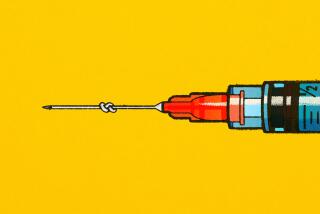Cosmetic surgery catches on in a more open Afghanistan
- Share via
KABUL, Afghanistan — Shoqofa never liked her nose. She thought it was too wide.
Her father told her not to worry; it was given to her by Allah.
But when the 22-year-old started working at a beauty salon, she had the means and freedom to do something about it.
Six months ago, she had rhinoplasty at one of several new private clinics offering cosmetic surgery in Kabul, Afghanistan’s capital. She paid for it herself, telling her father that she was seeing a doctor about a mole.
“When he saw my nose covered in bandages, he asked, ‘What happened?’ ” she said, laughing. “The whole family was surprised.”
Shoqofa, who, like many Afghans, uses one name, is part of an emerging middle class exposed to beauty trends from India and Iran through movies, travel and the country’s proliferating media outlets. Women show up at doctors’ offices carrying pictures of their favorite Bollywood celebrities and Turkish telenovela stars.
Just over a decade ago, women were largely confined to their homes and forbidden to work, even if they could find a job in the war-ravaged country. Cut off from the rest of the world under the Taliban’s rule, many had never heard of cosmetic surgery.
It remains a touchy subject in many Afghan families, especially for women, eliciting questions about their modesty and acceptance of God’s will. But as women have rejoined the workforce in cities like Kabul, they have started earning their own money, which some are choosing to spend on changing their looks.
Many have little idea what to expect from cosmetic surgery. Shoqofa’s doctor, Najibullah Najib, shows prospective patients before-and-after pictures on his cellphone. Most procedures are performed with a local anesthetic and patients are sent home the same day.
Najib honed his skills treating victims of war, poverty and domestic violence.
His patients include children born with clubfeet and cleft palates, survivors of gas-lamp fires and gunshot wounds, and girls who have set themselves alight in protest against forced marriages, often to much older men. In the last two years, he has also been getting a growing number of requests for cosmetic surgery.
Nose jobs and eyelid lifts are especially popular, he said. In many cases, the patients are ethnic Hazaras who he said are frequently mocked by Pashtuns and Tajiks, the country’s two largest ethnic groups, for their flat noses and distinctive eyes. Others have come to him for face-lifts and tummy tucks.
One recent morning, Mohammad Hanif, a man in a traditional tunic and turban, walked into Najib’s examination room at Kaisha Health Care with his 21-year-old daughter, Bibi, who was wrapped in a black veil that revealed only her eyes. She had already had surgery to correct a collapsed nose bridge, and he wanted the doctor to repair some skin discoloration.
Hanif said he had spent time in Iran, one of the world’s leading centers for cosmetic surgery. So when he heard on local television that these kinds of procedures were available in Afghanistan, he sought out Najib.
“When she was with her classmates, other girls were making fun of her because of her nose,” he said.
Such congenital defects can hurt a young woman’s marriage prospects, the doctor explained.
“It’s a conservative society,” he said. “Most of the people here don’t think about a girl’s talent or education, they think about her beauty.”
Benafsha, a 23-year-old law student in a red leopard-print head scarf and shearling jacket, asked Najib to excise several large scars running down one arm — the result of a car accident six years ago. Although her arms are covered in public, she likes to wear sleeveless dresses at women’s-only wedding parties and is tired of drawing stares.
Her mother, Fahima, a 43-year-old businesswoman, is thinking about a face-lift. She hates the wrinkles around her eyes. “I want to look young,” she said.
By the time Najib arrived at his afternoon job at the nearby Rose Dermatology and Cosmetics Hospital, the patients were lined up on blue plastic chairs, waiting for him.
A young woman named Mariam had brought in her 14-year-old niece, Shabnam. The girl had tried several times to slash her wrists after her parents died in a suicide bombing last year, Mariam said. Now she was threatening to drop out of school unless her aunt and uncle agreed to surgery to remove the scarring on her face from a childhood bout of leishmaniasis, a skin-sore-causing disease transmitted by sand flies.
“Whenever I see myself in the mirror, I feel depressed,” Shabnam said tearfully.
Najib said he sees many such cases. He used a ballpoint pen to show the pair how he would graft from a healthy part of her face.
As word spreads about the country’s cosmetic surgeons, some Afghans who live abroad are opting for cheaper procedures at home. Rhinoplasty here costs about $300 to $600. In the West, the price can be 10 or 20 times higher.
But some doctors worry about inexperienced colleagues setting up shop. Dr. Aminullah Hamkar, who trained in Russia and has two decades of experience, said others will attempt complicated procedures after a few months with a foreign medical aid group — often with unsatisfactory results.
Shoqofa said she did her research on the Internet and consulted numerous doctors before deciding on Najib. He performed the surgery the same day.
She loves her new, trim nose and displays the before-and-after pictures on a wall at home.
“I’m much happier,” she said.
Special correspondent Hashmat Baktash contributed to this report.
More to Read
Sign up for Essential California
The most important California stories and recommendations in your inbox every morning.
You may occasionally receive promotional content from the Los Angeles Times.













